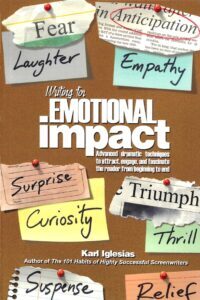Iglesias Focuses Authors on Emotions

Karl Iglesias. 2005. Writing for Emotional Impact: Advanced Dramatic Techniques to Attract, Engage, and Fascinate the Reader from Beginning to End. Livermore, CA: WingSpan Press.
Review by Stephen W. Hiemstra
An impatient world cries for stimulating images and direct speech, but yearns for furtive symbols and subtle inference. Pastors study body language to unpack the verbal ambiguities and deception. While women still read novels, men prefer movies, a medium that teases their eyes.
Introduction
Karl Iglesias introduced his thesis in Writing for Emotional Impact with these words:
“There are three kinds of feelings when reading a script—boredom, interest, and ‘WOW’. … This book is for writings who want to deliver that WOW, and who truly understand that great storytelling is about one thing only—engaging the reader emotionally.” (10)
And the reader that counts is the overworked, underpaid script-monkey who is tasked with summarizing your script, a report described as coverage (20-22).
He goes on to record two reasons for his book. First, to provide necessary information on how to evoke an emotional response, and, second, to avoid having to read more boring scripts (11). As an emotional delivery system, the screenplay should both tell a good story and tell it well (13-15).
Iglesias sees three types of story emotions—voyeuristic, vicarious, and visceral—that evoke curiosity, identify, and gut-wrenching emotions. We are curious about new information, worlds, and characters. We hopefully identify with the characters and feel what the characters feel (16). To emote is to disturb or agitate, as taken from the Latin (18).
Background and Organization
Karl Iglesias is a screenwriter, script doctor, and author. He is Cornell University graduate and earned a masters of fine arts at University of California at Riverside. He teaches writing with the UCLA Extension.
Iglesias writes in eleven chapters:
Introduction: The Emotion-Delivery Business
The Readers Your Only Audience
Concept: Unique Attraction
Theme: Universal Meaning
Character: Captivating Empathy
Story: Rising Tension
Structure: Engaging Design
Scenes: Mesmerizing Moments
Description: Riveting Style
Dialogue: Vivid Voices
Final Thoughts: Painting on the Page (vii-ix).
These chapters are preceded by acknowledgments and followed with an index.
Not the Usual Snipe Hunt
Fiction writing is harder than nonfiction writing. The complexity arises in fiction because the reader expects nonlinear elements to work together to produce emotionally satisfying storylines, characters, and themes. By contrast, the best nonfiction writing is a clear, simple, and linear exposition. Books on writing fiction often exhaust the reader with the spirit of a multifaceted snipe hunt. Ever wonder why so many writers become alcoholics?
Iglesias takes pity on young snipe-hunting writers by focusing their attention on the importance of reader emotional response in all aspects of writing. This focus lowers the complexity of the writing experience by offering a single performance measure. Writing is still hard, but it is not impossible—no alcohol required. Iglesias has done us all a big favor here.
Importance of Concept
Iglesias slips in a critical marketing tip: “A high concept script by a first-timer may sell, but it will often be rewritten by a seasoned professional … Nine times out of ten, if ta studio buys a script solely for its concept, they’ll get rid of you and hire a more established writer to rewrite the script.” (37) Because most of us have never sold a script, focusing on concept is the key strategy for breaking into the business of screenwriting.
So, what is a concept? Iglesias writes: “A great idea should be uniquely familiar, and it should promise conflict …. You could call the uniqueness of an idea a hook, gimmick, or a twist.” (26-27) I am reminded of “The Flying Nun” show (1967-70), but Iglesias’ mind runs to “Dinosaurs brough back to life for a modern theme park” the hook for Jurassic Park (27).
The importance of the concept comes as surprise for authors used to mooning over interesting characters and engaging plots, but it highlights the importance of commercializing a good screenplay. The cost of producing a film can run into the millions of dollars, which makes communicating an idea clearly a critical feature of the marketing process. Only this past week, a popular Hollywood star lost twenty million dollars of her own money on a project that flopped. What does that say about someone else buying one your scripts? Concept matters; it matters a lot.
Assessment
Karl Iglesias’ Writing for Emotional Impact is an engaging read on a topic of critical importance to aspiring authors, especially screenwriters. While novelists often ignore books on screenwriting, this is a big mistake. As the number of readers declines day after day and the number of authors rises with the ease of self-publishing, novelists need to pay more attention to marketing. A good place to start is by looking over the shoulders of screenwriters who have always been more focused on the problem. Writing for Emotional Impact is a good place to start.
Footnotes
For those unaware, a snipe hunt is a camp tradition where late in the afternoon new initiates are given an empty bag and encouraged to go into the woods to hunt a mythical bird, known as a snipe.
Iglesias Focuses Authors on Emotions
Also see:
The Face of God in the Parables
The Who Question
Preface to a Life in Tension
Other ways to engage online:
Author site: http://www.StephenWHiemstra.net
Publisher site: http://www.T2Pneuma.com
Newsletter at: https://bit.ly/East_Apr2024 , Signup
The post Iglesias Focuses Authors on Emotions appeared first on T2Pneuma.net.



